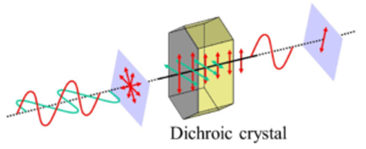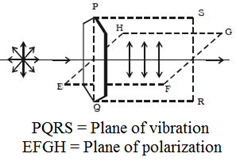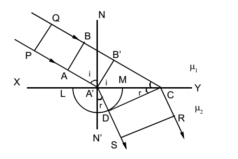Science > Physics > Magnetic Effect of Electric Current >Numerical Problems on Toroids or Rowland Ring Example 01: A Rowland ring (toroid) of ferromagnetic material of a mean radius 15 cm has 3000 turns of wire wound it. The relative permeability of the material is 1000. What is the magnetic field in a core when […]
Polaroids and Their Applications

Science > Physics > Wave Theory of Light > Polaroids In this article, we shall study the use of the phenomenon of polarization of light, principle, construction, and working of polaroids. Double Refraction: In the case of some crystals like calcite or quartz, a single ray of unpolarized light from a point source of light […]
Polarization of Light

Science > Physics > Wave Theory of Light > Polarization of Light In this article, we shall study the concept of polarization of light, Brewster’s law associated with it. Ordinary Light: Light waves are transverse in nature. The direction of its vibration is in the plane which is perpendicular to the direction of propagation of […]

Science > Physics > Wave Theory of Light > Numerical Problems on wave Theory of Light In this article, we shall study to solve the problems on the calculation of the refractive index, angle of refraction, the wavelength of light and wavenumber of waves using snell’s law and the definition of the refractive index of […]

Science > Physics > Wave Theory of Light > Numerical Problems on wave Theory of Light In this article, we shall study to solve the problems on the calculation of the refractive index, angle of refraction, the wavelength of light and wavenumber of waves using snell’s law and the definition of the refractive index of […]

Science > Physics > Wave Theory of Light >Application of Huygens Wave Theory of Light In the last article, we had a brief idea of the Huygens wave theory of light. In this article, we shall study its use to explain the phenomena of reflection and refraction of light. Huygens Principle: Huygens Proposed that Every […]
Wave Theory of Light

Science > Physics > Wave Theory of Light > Introduction to Wave Theory of Light In this article, we shall study various theories proposed to explain the nature of light. The main focus of the article will be on Huygens’s wave theory of light Newton’s Corpuscular Theory of Light Assumptions of Newton’s Corpuscular Theory of […]
Science > Physics > Thermal Properties of Matter and Thermodynamics > Applications of Expansion of Solids Linear expansion or longitudinal expansion refers to the increase in length of a solid material when its temperature rises. This phenomenon occurs due to the increased thermal energy within the material, causing its constituent particles to vibrate more vigorously, […]
Science > Physics > Expansion of Solids > Numerical Problems on Linear Expansion of Solids In this article, we shall study to solve problems to calculate the coefficient of linear expansion of solid, final length and the change in temperature. Example – 01: A metal scale is graduated at 0 oC. What would be the […]
Expansion of Solids
Science > Physics > Thermal Properties of Matter and Thermodynamics > Expansion of Solids Whenever there is an increase in the dimensions of a body due to heating, then the body is said to be expanded and the phenomenon is known as expansion of solids. Solids undergo three types of expansions a) Linear (Longitudinal) expansions, […]